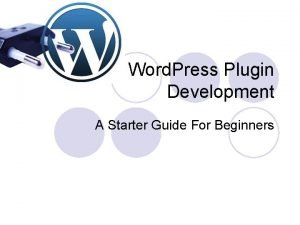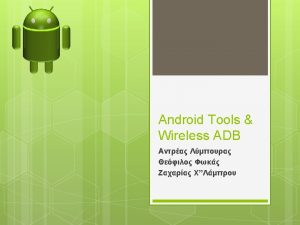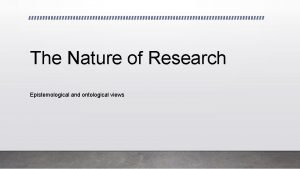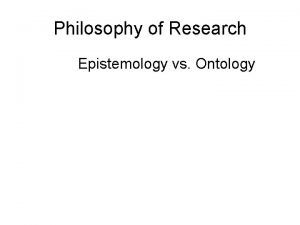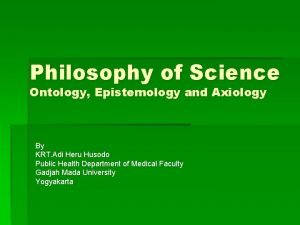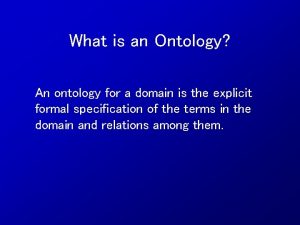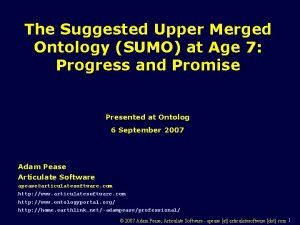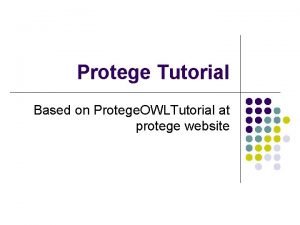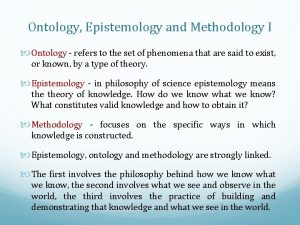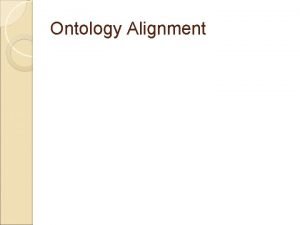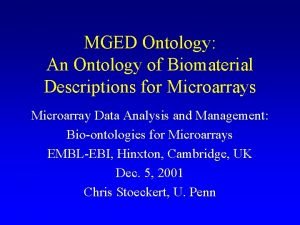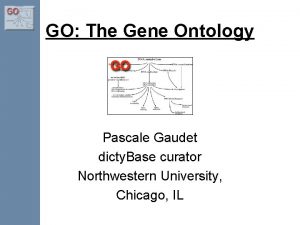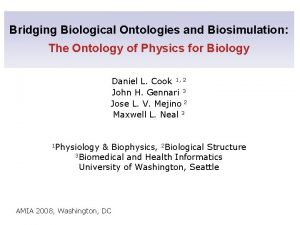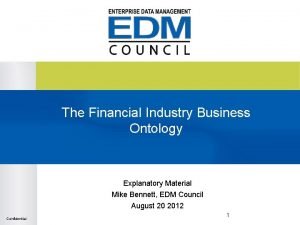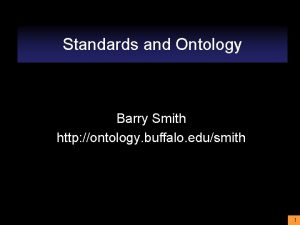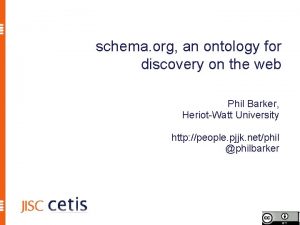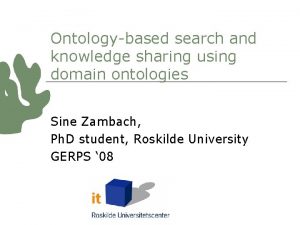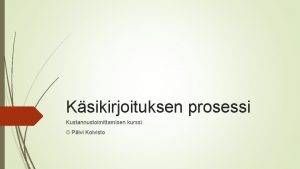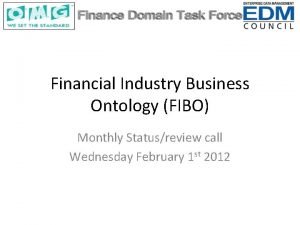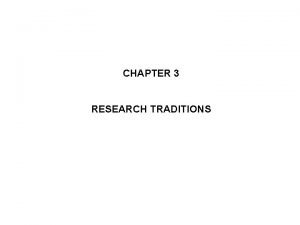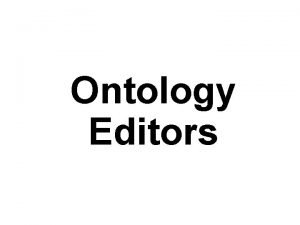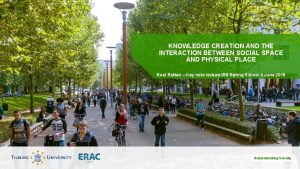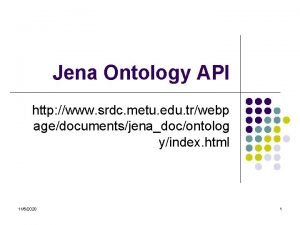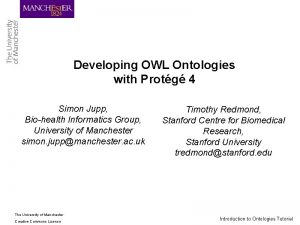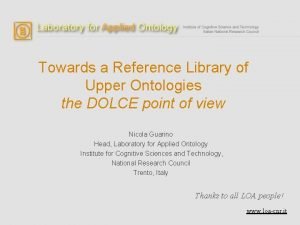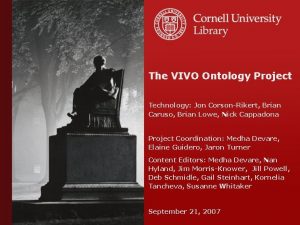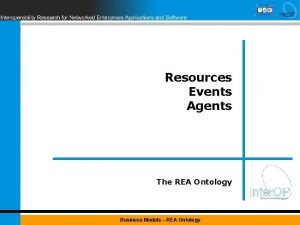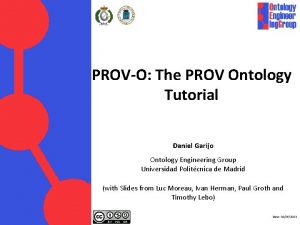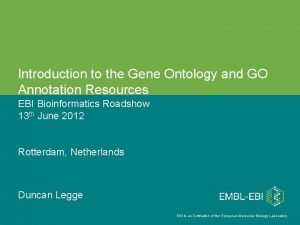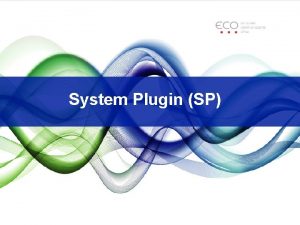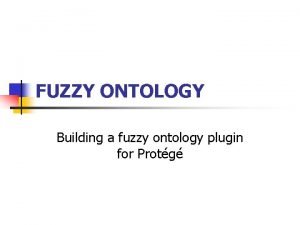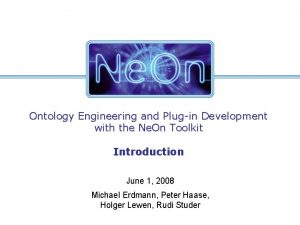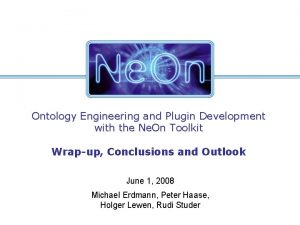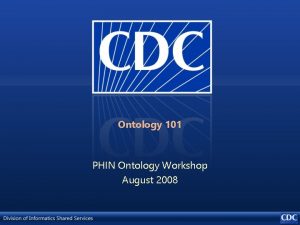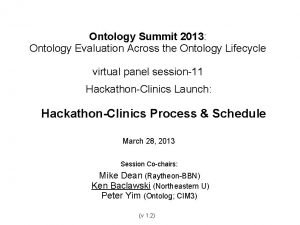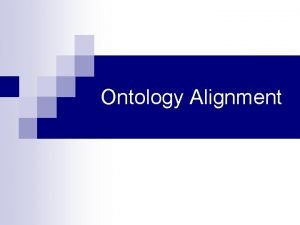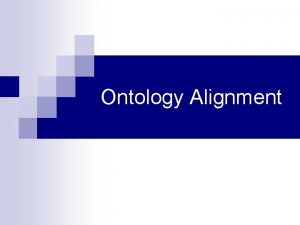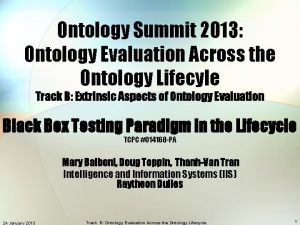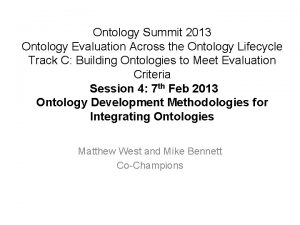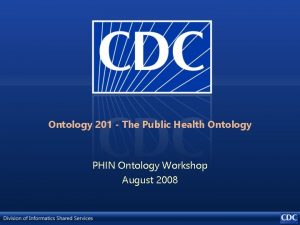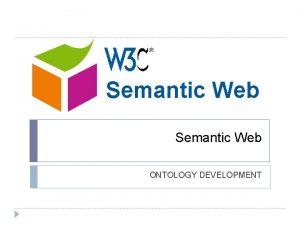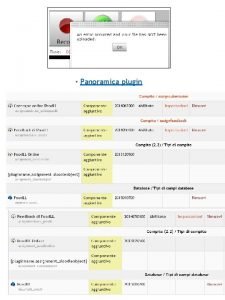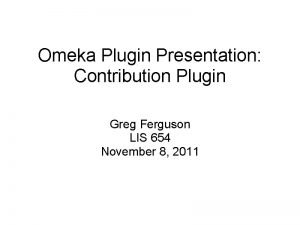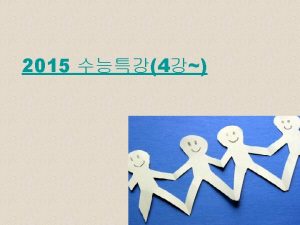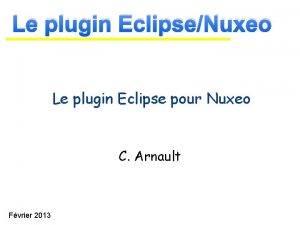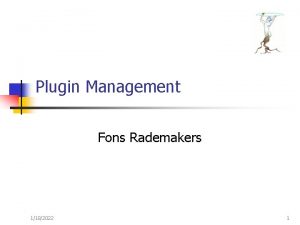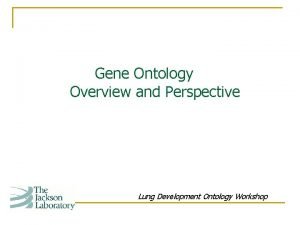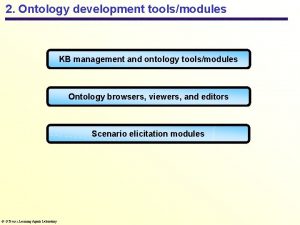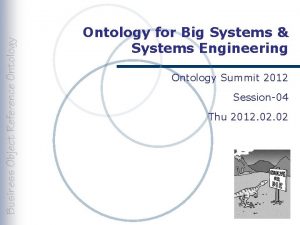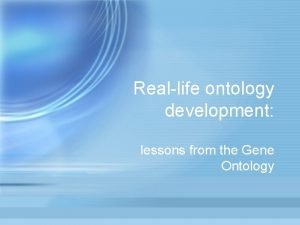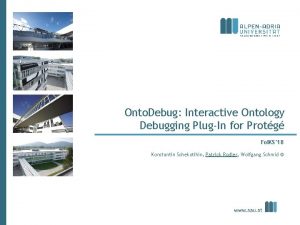Ontology Engineering and Plugin Development with the Ne





























- Slides: 29

Ontology Engineering and Plug-in Development with the Ne. On Toolkit Ontology Lifecycle and Methodology June 1 st, 2008 Michael Erdmann, Peter Haase, Holger Lewen, Rudi Studer

Ontological Engineering § Ontological Engineering refers to the set of activities concerning: – – – the ontology development process the ontology lifecycle the methods and methodologies for building ontologies, the tool suites and languages that support them IST-2005 -027595 Ne. On-project. org

„I want to build my ontology“ § Commonly asked questions related to ontological engineering: – – – What are the activities involved in the ontology development process? What is the goal of each activity? When should I carry out each activity? Where is the relationship of one activity with the others? Where can I find ontologies to reuse? IST-2005 -027595 Ne. On-project. org

The Ne. On Glossary of Activities § The Ne. On Glossary of Activities identifies and defines the activities that are carried out when ontology networks are collaboratively built § They can be found at www. neon-project. org as part of Deliverable 5. 3. 1 “Ne. On Development Process and Ontology Lifecycle“ IST-2005 -027595 Ne. On-project. org

Table of “Recommended and If-Applicable” Activities § In the deliverable, a table indicates whether activities are core (required) or optional Required Ontology Conceptualization X Ontology Evaluation X Ontology Integration X Knowledge Acquisition for Ontologies X Optional Ontology Learning X Ontology Localization X Ontology Matching X Ontology Search X Ontology Specification X IST-2005 -027595 Ne. On-project. org

The Ontology Lifecycle IST-2005 -027595 Ne. On-project. org Slide 6

Ontology Lifecycle with Activities IST-2005 -027595 Ne. On-project. org Slide 7

Ontology Development: Conceptualization and Formalization § Disclaimer: This is not intended to be a complete OWL Tutorial § Our main goal is to explain the process of ontology development with a small example § We are developing an application ontology § For a comprehensive OWL tutorial, see – http: //www. co-ode. org/resources/tutorials/ IST-2005 -027595 Ne. On-project. org Slide 8

Basic Methodology § Build glossary of terms – Identify the entities one can encounter in the universe of discourse – Identify concepts that group these entities. – Distinguish independent concepts from relationship-roles. § Build a taxonomy of concepts – Revisit this later and consider issues such as disjointness. § Describe binary relations and attributes – Identify ‘properties’ of entities, and then identify general relationships in which objects participate. § „Formalize“ the ontology – E. g. determine local restrictions on relations and attributes, such as cardinality limits and value restrictions. § Describe instances – Identify any instances that are of interest in all states of the world in this universe of discourse IST-2005 -027595 Ne. On-project. org

Basic Methodology 1. - Build glossary of terms Identify the entities one can encounter in the universe of discourse Identify concepts that group these entities. Distinguish independent concepts from relationship-roles. IST-2005 -027595 Ne. On-project. org

Basic Methodology 1. - Build glossary of terms Identify the entities one can encounter in the universe of discourse Identify concepts that group these entities. Distinguish independent concepts from relationship-roles. IST-2005 -027595 Ne. On-project. org

Basic Methodology 2. - Build a taxonomy of concepts Revisit this later and consider issues such as disjointness. IST-2005 -027595 Ne. On-project. org

Basic Methodology 2. - Build a taxonomy of concepts Revisit this later and consider issues such as disjointness. IST-2005 -027595 Ne. On-project. org

Basic Methodology 3. - Describe binary relations and attributes Identify ‘properties’ of entities, and then identify general relationships in which objects participate. IST-2005 -027595 Ne. On-project. org

Basic Methodology 3. - Describe binary relations and attributes Identify ‘properties’ of entities, and then identify general relationships in which objects participate. IST-2005 -027595 Ne. On-project. org

Basic Methodology 3. - Describe binary relations and attributes Identify ‘properties’ of entities, and then identify general relationships in which objects participate. IST-2005 -027595 Ne. On-project. org

Basic Methodology 4. - „Formalize“ the ontology E. g. determine local restrictions involving properties, such as cardinality limits and value restrictions. IST-2005 -027595 Ne. On-project. org

Basic Methodology 5. - Describe instances Identify any individuals that are of interest in all states of the world in this universe of discourse IST-2005 -027595 Ne. On-project. org

Ontology Lifecycle with Activities IST-2005 -027595 Ne. On-project. org Slide 19

Searching Ontologies § Ontology Registries § OMV: Ontology Metadata Vocabulary (http: //omv. ontoware. org/) IST-2005 -027595 Ne. On-project. org

Next Generation Semantic Web Applications IST-2005 -027595 Ne. On-project. org

Watson Ne. On Toolkit plugin § While building an ontology with the Neon toolkit § Find descriptions of existing entities in Web ontologies § Integrate these descriptions into the edited ontology § Thus allowing knowledge reuse at the scale of the Semantic Web § In one simple, integrated, and interactive tool IST-2005 -027595 Ne. On-project. org

Ontology Selection Example: Selecting a Time Ontology 1. Identification of criteria for comparing the candidate set of temporal ontologies Time Points Time Interval Distinction between open and closed intervals Absolute and Relative Time Explicit modeling of proper intervals Relations between time intervals Concatenation of intervals Convex and non convex intervals Different temporal granularities 2. Assess all existing temporal ontologies against the criteria Cyc’s Unrestricted Simple Upper Time Ontology Time Points Time Interval Reusable Time Ontology Kestrel Time Ontology Absolute and Relative Time SRI’s SUMO Time DAML Time AKT Time Ontology Relations between time intervals Convex and non convex intervals Distinction between open and closed intervals Explicit modeling of proper intervals Concatenation of intervals Different temporal granularities Provides axioms IST-2005 -027595 Ne. On-project. org

Process for assessing Time Ontologies (II) 3. Checking which temporal properties are needed for answering the competency questions a. b. c. d. e. f. g. h. i. 4. When the job seeker completed his/her first degree? Is the job seeker older than 30 years? How much time did the job seeker spend completing his/her first degree? How long is the duration of the contract? Which job offers were posted in last 24 hours? Which job offers were posted in last 7 days? Which job offers were posted in last month? Was the job seeker unemployed? Was the job seeker a student between 1995 and 2000? Checking which temporal properties are needed for answering the competency questions IST-2005 -027595 Ne. On-project. org Time Points a Time Interval b, c Absolute and Relative Time a, d, f, g Relations between time intervals Convex and non convex intervals h Explicit modeling of proper intervals i Concatenation of intervals Different temporal granularities a, d, f, g

The Time Ontology Selection Cyc’s Unrestricted Simple Upper Time Ontology Time Points Time Interval Absolute and Relative Time Reusable Time Ontology Kestrel Time Ontology SRI’s SUMO Time DAML Time AKT Time Ontology Relations between time intervals Convex and non convex intervals Distinction between open and closed intervals Explicit modeling of proper intervals Concatenation of intervals Different temporal granularities Provides axioms IST-2005 -027595 Ne. On-project. org

Ontology Lifecycle with Activities IST-2005 -027595 Ne. On-project. org Slide 26

Ontology Evaluation § Evaluation – User Guidance Tools for Design Support – Consistency checks during development process – Support for error recovery and debugging § What is a ‘good’ ontology? – Usage, application performance, data coverage, corpus fit, reasoning adequacy ? – Well-known: Onto. Clean (formal evaluation of taxonomic relationships), developed by Guarino and Welty – System of conceptual tags (Rigidity, Unity, Identity, Independence) + constraints on possible subsumption relations (e. g. ~R can‘t subsume +R) – Onto. Clean is based on philosophical principles and is even hard to understand for experts – AEON approach tries to (automatically) approximate the tagging with Onto. Clean IST-2005 -027595 Ne. On-project. org Slide 27

Ontology Evaluation §Verification §Validation Did I engineer the correct ontology? Did I engineer the ontology correctly? § Specification is best possible model § Model is grounded in reality “An ontology is the formal specification of a shared conceptualization. ” IST-2005 -027595 Ne. On-project. org Slide 28

Ontology Evaluation § Quality Criteria: – – – – Accuracy Adaptability Clarity Completeness Computational efficiency Conciseness Consistency Organizational fitness IST-2005 -027595 Ne. On-project. org Slide 29
 Word plugin development
Word plugin development Android development tools (adt)
Android development tools (adt) What is epistemology in research
What is epistemology in research What is epistemology in research
What is epistemology in research Ontology, epistemology, axiology
Ontology, epistemology, axiology What is an ontologist
What is an ontologist Suggested upper merged ontology
Suggested upper merged ontology Protege user guide
Protege user guide Ontology versus epistemology
Ontology versus epistemology Ontology alignment
Ontology alignment Types of ontology
Types of ontology Dicty base
Dicty base Ontology in biology
Ontology in biology Financial industry business ontology
Financial industry business ontology Barry smith ontology
Barry smith ontology Schema.org
Schema.org Basic formal ontology
Basic formal ontology Ontology kurssi
Ontology kurssi Fibo ontology
Fibo ontology Ontology vs epistemology vs methodology
Ontology vs epistemology vs methodology Ontology editors
Ontology editors Ontology creation
Ontology creation Metu class
Metu class Pizza ontology download
Pizza ontology download Dolce ontology
Dolce ontology Vivo ontology
Vivo ontology Rea ontology
Rea ontology Provi tutorial
Provi tutorial Sims position
Sims position Gene ontology
Gene ontology
